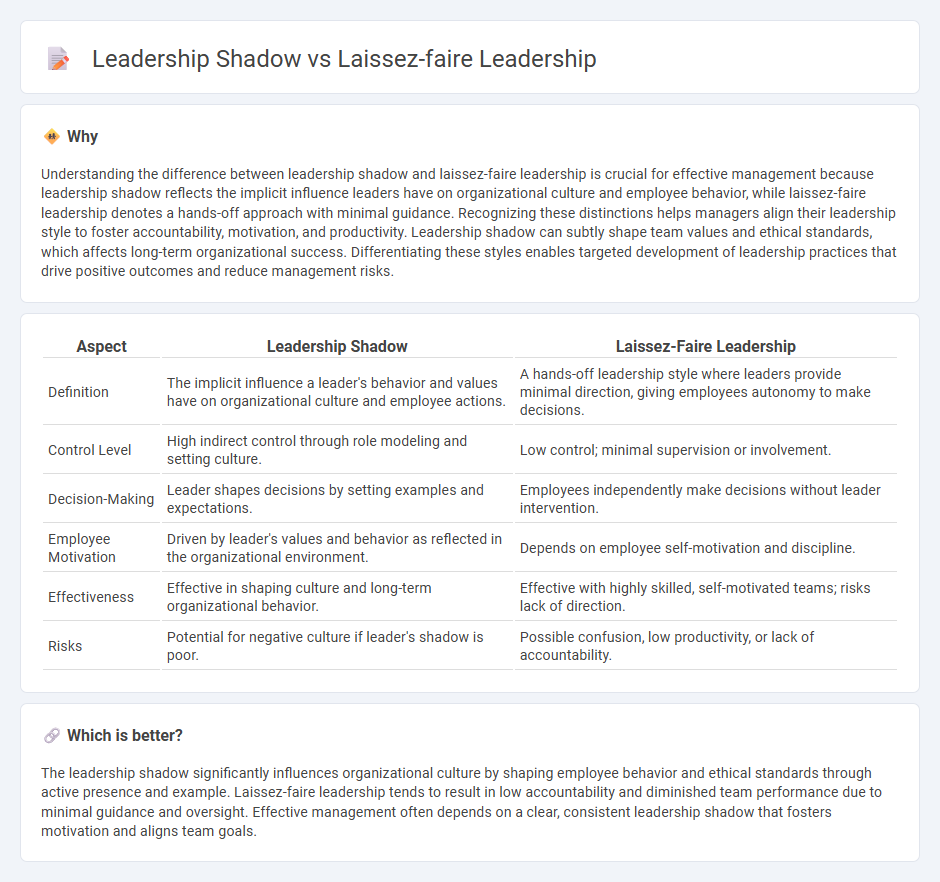
Leadership shadow reflects the influence a leader's behavior and decisions cast on organizational culture and employee motivation, shaping performance and morale. Laissez-faire leadership involves minimal direct supervision, granting employees autonomy to make decisions but potentially leading to ambiguity and decreased accountability. Explore the nuances between leadership shadow and laissez-faire leadership to understand their impact on management effectiveness.
Why it is important
Understanding the difference between leadership shadow and laissez-faire leadership is crucial for effective management because leadership shadow reflects the implicit influence leaders have on organizational culture and employee behavior, while laissez-faire leadership denotes a hands-off approach with minimal guidance. Recognizing these distinctions helps managers align their leadership style to foster accountability, motivation, and productivity. Leadership shadow can subtly shape team values and ethical standards, which affects long-term organizational success. Differentiating these styles enables targeted development of leadership practices that drive positive outcomes and reduce management risks.
Comparison Table
| Aspect | Leadership Shadow | Laissez-Faire Leadership |
|---|---|---|
| Definition | The implicit influence a leader's behavior and values have on organizational culture and employee actions. | A hands-off leadership style where leaders provide minimal direction, giving employees autonomy to make decisions. |
| Control Level | High indirect control through role modeling and setting culture. | Low control; minimal supervision or involvement. |
| Decision-Making | Leader shapes decisions by setting examples and expectations. | Employees independently make decisions without leader intervention. |
| Employee Motivation | Driven by leader's values and behavior as reflected in the organizational environment. | Depends on employee self-motivation and discipline. |
| Effectiveness | Effective in shaping culture and long-term organizational behavior. | Effective with highly skilled, self-motivated teams; risks lack of direction. |
| Risks | Potential for negative culture if leader's shadow is poor. | Possible confusion, low productivity, or lack of accountability. |
Which is better?
The leadership shadow significantly influences organizational culture by shaping employee behavior and ethical standards through active presence and example. Laissez-faire leadership tends to result in low accountability and diminished team performance due to minimal guidance and oversight. Effective management often depends on a clear, consistent leadership shadow that fosters motivation and aligns team goals.
Connection
Leadership shadow reflects the implicit influence a leader's behavior casts on organizational culture, shaping team dynamics and performance. Laissez-faire leadership, characterized by minimal direct intervention, often creates a leadership shadow marked by ambiguity and decreased accountability. This connection highlights how passive leadership styles can implicitly define organizational norms and impact employee motivation and engagement.
Key Terms
Autonomy
Laissez-faire leadership emphasizes granting team members significant autonomy to make decisions with minimal interference from leaders, fostering independence and self-direction. Leadership shadow reflects the subtle, often unconscious influence leaders exert on organizational culture and employee behavior, which can either support or undermine autonomy. Explore how balancing these dynamics enhances effective leadership and drives organizational success.
Influence
Laissez-faire leadership minimizes direct influence by allowing team members autonomy and non-interference, which can result in decreased guidance and accountability. Leadership shadow represents the implicit influence a leader exerts through behaviors, values, and decisions, significantly shaping organizational culture and employee mindset. Discover how understanding these leadership styles can transform your approach to influence and team dynamics.
Accountability
Laissez-faire leadership often results in diminished accountability as leaders provide minimal guidance, allowing team members to operate independently, which can lead to inconsistent performance. In contrast, the leadership shadow emphasizes how leaders' actions, even in passive moments, set behavioral standards, directly impacting accountability within the organization. Explore how understanding these leadership styles can enhance responsibility and performance in your team.
Source and External Links
Understanding Laissez-Faire Leadership: Benefits and Strategies - Laissez-faire leadership is a management approach where leaders provide minimal oversight, allowing employees considerable autonomy in decision-making and task management.
Laissez-Faire Leadership Style - This style involves leaders giving group members minimal guidance, allowing them to determine goals, make decisions, and resolve problems independently.
What Is Laissez-Faire Leadership? - Laissez-faire leadership is characterized by a hands-off approach, where leaders allow team members to make their own decisions and work independently with minimal interference.
 dowidth.com
dowidth.com